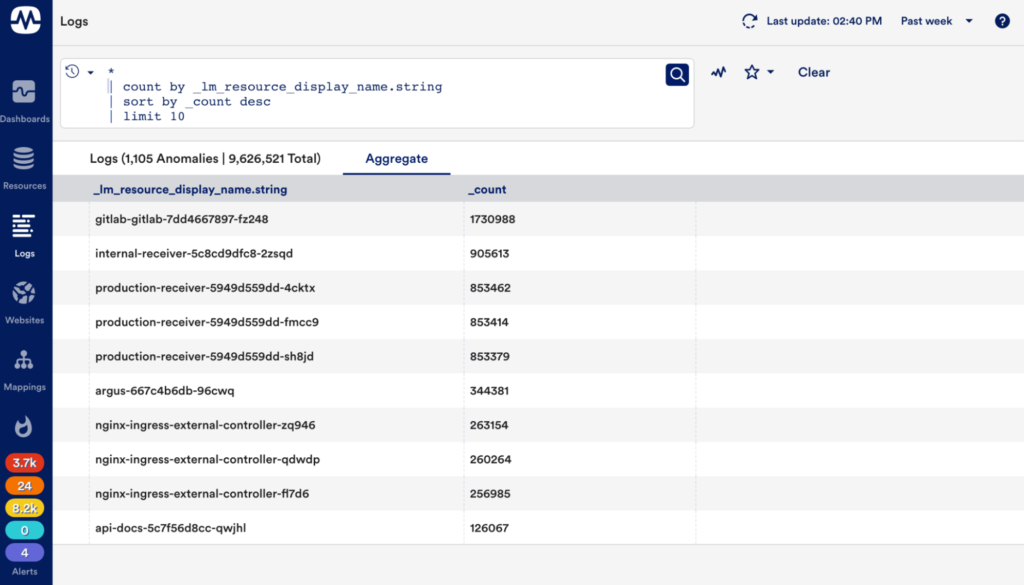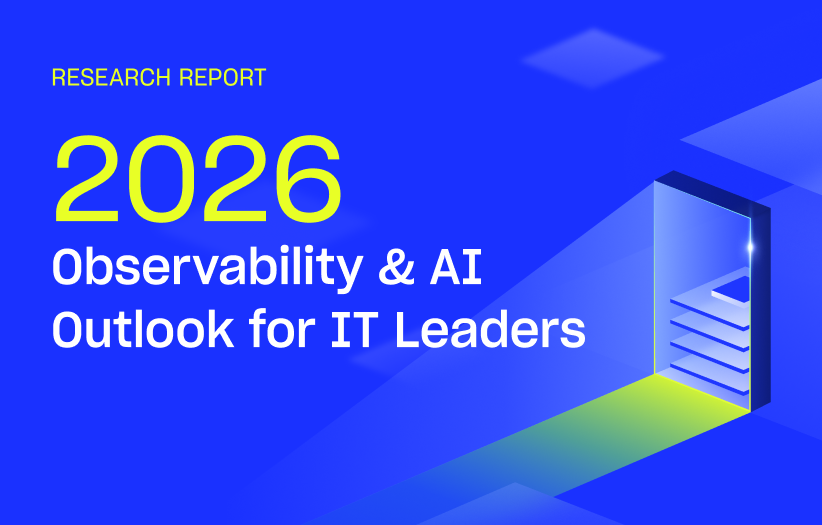Updated on December 20
Fixed an issue that prevented the Microsoft_Azure_AutomationAccountCertificates LogicModule from collecting and reporting data.
Updated on December 10
An update for v162 fixes an issue that prevented the Alerts List widget from displaying alerts. This update is scheduled to be released from December 13 to December 20.
Highlights
- Feature Highlights: Expanded the log search language to support aggregate functions. Added a new Log Usage DataSource to monitor log volume. Released GD Collector 31.000 and Argus v.6.1.0.
- General Updates: Improved logs search performance, added the ability to share log searches with a URL, updated audit log formats for alert thresholds, and more.
- Updated Monitoring: New LogicModules to monitor devices running Selenium and devices running NTPv4.
Feature Highlights
New search aggregate functions

You can now search logs using aggregate functions such as count, filter, limit, parse, and where. After running the search, the results are displayed in a new Aggregate tab. We will continue to expand the search language to include more aggregate functions in future releases. For more information, see Logs Search Language.
Note: This feature is only available for LM Logs Enterprise and Unlimited customers.
New Log Usage DataSource

The new Log Usage DataSource has been added to all resources that send logs to LM Logs. The Log Usage DataSource includes the number of log events and the size of the log message. This allows you to view volume anomalies and leverage dynamic thresholds for alert generation when a resource is generating logs at an unexpected rate.
GD Collector 31.000 released
GD Collector 31.000 was released on November 26 and includes all features and fixes from EA Collector 30.104, updated Java to Amazon Corretto 11.0.13.8, and more. For more information, see GD Collector 31.000 Release Notes.
Argus 6.1.0 released
Argus 6.1.0 was released and includes the following updates and fixes:
- Supports Kubernetes (K8S) 1.22, with updated Helm charts for Argus 1.1.0 and Collector-set Controller 0.12.0.
- Support for the new Resource tree can be enabled through Helm chart configuration.
- Minor bug fixes for handling device deletion.
- Externalized the time period for retaining Argus and Collector-set Controller pods after deletion.
General Updates
Alerts
Bug Fixes
- Fixed an issue where adding a note within an EventSource alert would incorrectly clear the alert status.
Audit Logs
Enhancements
- Changed the format of audit logs to make the time zone parsable for alert threshold details. The audit logs do not capture details of before and after time zone when the alert threshold is updated at the group level.
Cloud Monitoring
Enhancements
- Added capability to monitor AWS Transit Gateway Attachments.
Bug Fixes
- Instances without corresponding DataSources for the GCP Cloud APIs have been removed from the resource tree.
- Updated documentation, in-product text, and test permissions functionality to include several missing AWS IAM permissions. If customers are receiving AWS STS errors, they should update the AWS IAM Policy attached to the role they provided LogicMonitor to reduce or eliminate these errors.
- Fixed an issue to ensure that LogicMonitor correctly discovers all AWS CloudFront resources when there are more than 100 instances.
LM Logs
Enhancements
- Improved performance for executing log searches. Logs are retrieved asynchronously for faster returns of the log graph histogram and log table results.
- Added the ability to share a URL to the current query with the option to select an absolute or relative time range. This link can be found in the overflow menu (three dots in the upper right corner of the Logs page).
LogicModules
Bug Fixes
- Fixed an issue where PropertySources would fail without warning when output reached 100 records. The following error now displays: “Warning: A maximum of 100 properties will be applied.”
- Fixed an issue to improve the response time for AppliesTo functions.
Resources
Bug Fixes
- Fixed an issue where dynamic group membership was not updating for system.collectorid.
LogicModule Releases
New and updated LogicModules are available for you to import from the LogicMonitor Public Repository. This section lists the LogicModules that are new in this release, updated in this release, or will be removed in a future release. Changes related to the LogicModule feature will be listed under General Updates.
New LogicModules
| LogicModule Name | Details |
| LogicMonitor_Collector_SyntheticsSelenium addCategory_SyntheticsCollector |
(1 DataSource, 1 PropertySource) Monitoring for devices running SyntheticsSelenium and corresponding PropertySource to determine Collectors that are monitoring at least one Selenium device. |
| NTPv4 | (1 DataSource) Supports NTPv4 which is backward compatible with NTPv3. The old NTP module is kept to support devices running NTPv2 or earlier. See also Updated LogicModules: addCategory_NTPResponds |
Updated LogicModules
| LogicModule Name | Details |
| Cisco_DNAC_Devices | (1 DataSource) Additional statuses for reachabilityStatus and updated alert thresholds. |
| Cisco_Entity_Sensors | (1 DataSource) Now ignores unnamed sensors by default (which are often unreliable as well as hard to action upon issue). This behavior can be reverted via the “sensor.use_modifiers” host property. |
| Cisco_Meraki_Licensing | (1 DataSource) Added new license status “License Required” with status code 1. “License Expired” status is now 2 in order to facilitate ease of alerting. |
| GCP_Billing_CostByOperation_BigQuery GCP_Billing_CostByProject_BigQuery GCP_Billing_CostByService_BigQuery |
(3 DataSources) These modules were previously collecting on a daily basis. They now retrieve monthly stats and only perform Active Discovery once a day. |
| Microsoft_Windows_Services | (1 DataSource) Updated recommended threshold for AutomaticStart_NotRunning in the datapoint description. |
| SilverPeak_System_Status | (1 DataSource) Fixed casing typo in disk usage API endpoint. |
| VMware_VeloCloud_EdgeHealth VMware_VeloCloud_EdgeLinkEventQuality VMware_VeloCloud_EdgeLinkHealth VMware_VeloCloud_EdgeLinkMetrics addCategory_VeloCloudAPI |
(4 DataSources, 1 PropertySource) Updated proxy code to support device host property for proxy.host and proxy.port to override settings in the Collector. |
| addCategory_MSSQL | (1 PropertySource) Updated AppliesTo to exclude devices with “SQL_Node” category. It’s important to note that for SQL Failover Clusters and Always on Availability Groups, the addCategory_WindowsFailoverCluster PropertySource must be run before this one to ensure the correct categories and device properties are applied. |
| addCategory_NTPResponds | (1 PropertySource) Added detection for NTP version to apply new category “NTPRespondsV3+” where applicable. |
| addCategory_TopoSwitch | (1 PropertySource) Corrected typo in property name system.categories. |
| addCategory_Ubiquiti_UniFi | (1 PropertySource) Removed unnecessary check on login response that prevented script from completing on some devices. |
| addCategory_VMwareHorizonConnectionServer | (1 PropertySource) Removed VMware Horizon Agent from assigning category “VMwareHorizonConnectionServer” to devices only running the Horizon Agent. |
| addERI_Device addERI_Linux addERI_Windows |
(3 PropertySources) Added VM detection. |
\.1\.3\.6\.1\.4\.1\.15497\.1\.2
|
(1 SNMP sysOID Map) Updated a sysOID map to include the Ironport category. |
Deprecated LogicModules
This table lists LogicModules that we are deprecating in this release. This means that these LogicModules will be removed in a future release. If available, a replacement LogicModule is listed.
| LogicModule Name Deprecated/Replacement |
Details | End of Support Date |
Removed:\.1\.3\.6\.1\.4\.1\.15497\.1\.(1|2)
Replacement: N/A |
(1 SNMP sysOID Map) Removed a sysOID map because it is duplicated by existing maps. |
N/A |
For the list of LogicModules deprecated over the past five releases, see the support article Deprecated LogicModules.
Looking Ahead
In this section, you will find announcements about upcoming beta features, updates about ongoing beta features, and information about the end-of-life of existing features.
LogicMonitor APM Lighthouse Program
LogicMonitor APM has been available in a limited release capacity for the past few months. We are now getting ready to expand access with the launch of our Lighthouse Program for users that want access to our APM capabilities. Along with early access, qualified customers and prospects will have the opportunity to influence the early direction of our product and provide feedback to enhance our APM offering.
If you are interested in participating in our Lighthouse Program, please fill out the Google form here.
MGD Collector 30.001 Update
The automatic update to MGD Collector 30.001 will deploy on January 10, 2022. This release, which was scheduled for deployment on October 27th, was postponed while we fixed a performance issue. Although no action is required ahead of this date, we do recommend that you update to MGD Collector 30.001 as soon as possible. For more information, see MGD Release Update.




